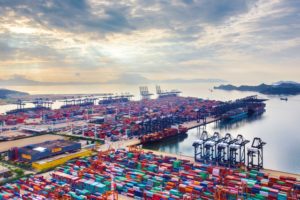
The Chinese port operator Cosco Shipping Ports (CSP) has finished year 2017 with a 12.6% rise in the throughput across its overall terminal portfolio, up to 87.312 mln TEU from 77.572 mln TEU in 2016. This signals CSP’s potential to become the largest global terminal operator displacing Hutchison Ports from the #1 position.
Hutchison Ports have not published its 2017 results yet. In 2016, its total annual throughput was 81.4 mln TEU.
Earlier, Drewry Shipping Consultants forecasted that CSP would become the world’s leader among the terminal operators by 2020. In its Global Container Terminal Operators annual report 2017, Drewry indicated: “The China Cosco Shipping group is projected to add the most capacity of any of the global/international terminal operators over the next five years.”
And indeed, according to the recently published statistics, CSP’s most gains in throughput happened thanks to the overseas ports, which now account for 22% of the Group’s total volume. These handled 18.840 mln TEU in 2017, up 38.7%. This includes the November and December throughput of 554,000 TEU of the Spanish Noatum Port Holdings (sea terminals in Valencia and Bilbao as well as dry ports in Madrid and Zaragoza), where CSP acquired 51% last year, the deal completed on 30 October 2017.
However, the largest growth among the overseas ports was shown by Euromax Terminal Rotterdam B.V.: +312%, up to 2.693 mln TEU, Busan Port Terminal: +70.5%, up to 3.554 mln TEU and Kumport in Turkey: +60%, up to 1.063 mln TEU.
In China, the Pearl River Delta terminals, which currently account for 31% in the Group’s throughput, recorded a 9.5% growth (27 mln TEU), whereas the Yangtze River Delta region, which is the second largest port cluster of CSP, saw its throughput grow by 6.1% to 19.630 mln TEU. The northern Bohai Rim ports barely grew, their volumes increased just by 1.6% to 15.355 mln TEU, demonstrating the slowest annual growth rate among all the Group’s regions.
